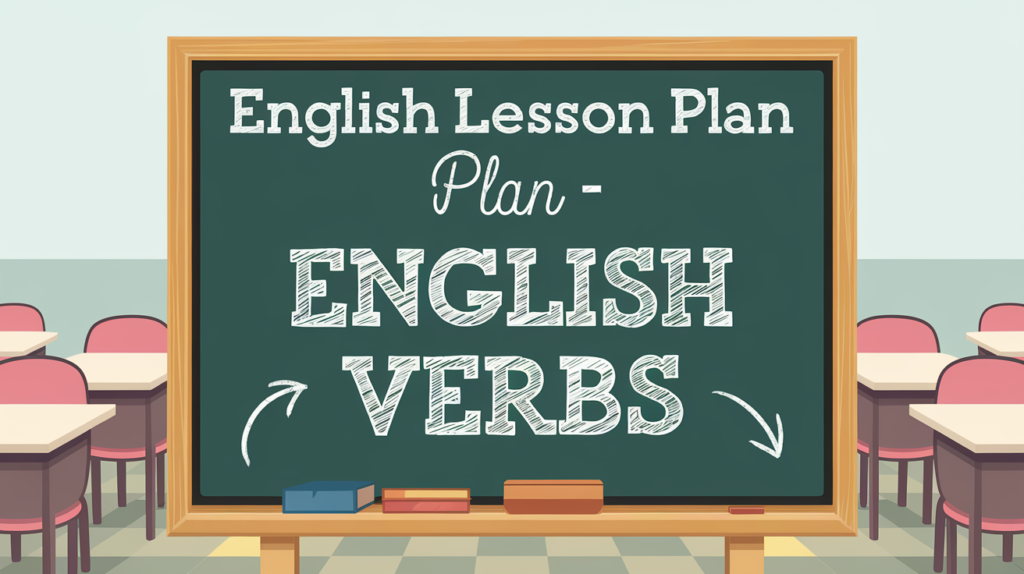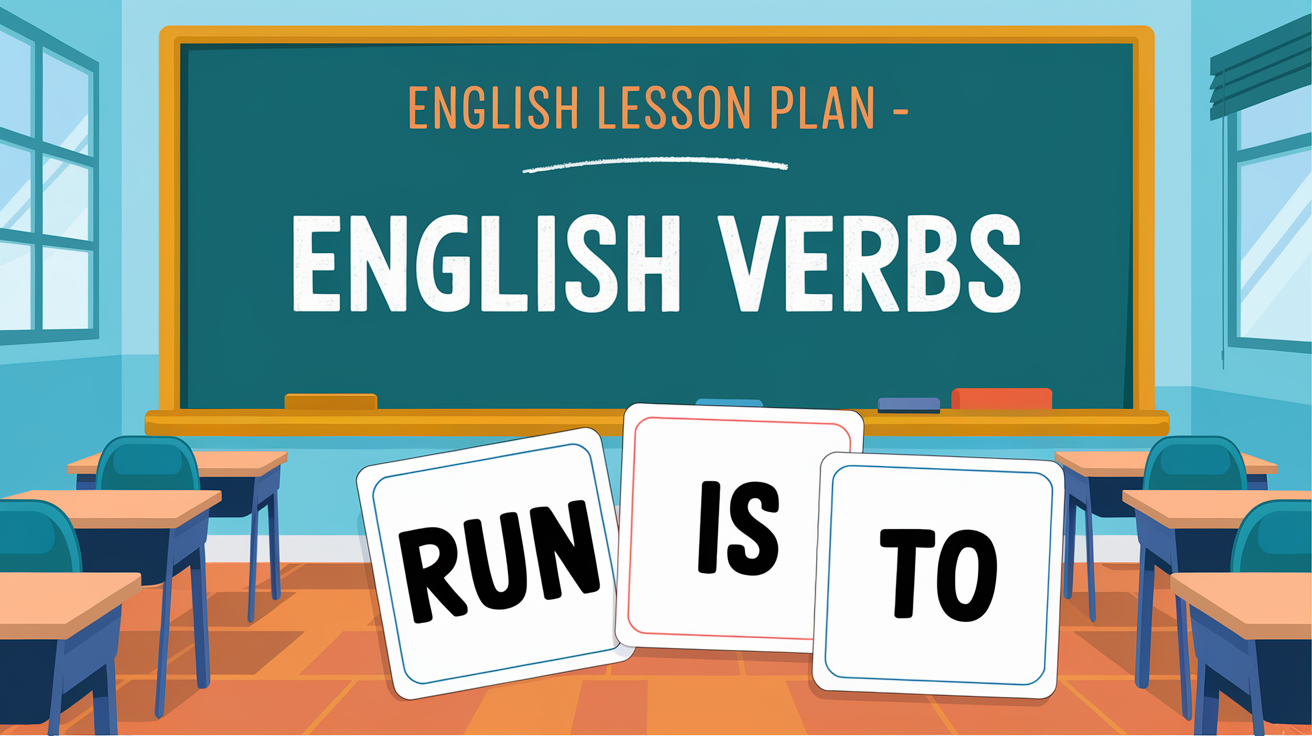Goal:
- Realize the importance of verbs in a sentence.
- Learn how to use verbs in the right situation.
- Choose appropriate verbs to construct meaningful sentences.
Objectives
By the end of this lesson, students should be able to:
- Differentiate between different types of English verbs.
- Identify verbs within sentences.
- Rewrite sentences by changing verbs appropriately.
- Participate actively, demonstrating understanding of English verbs.
Materials Needed
- Internet Access: Explore online resources about English verbs.
- Basic Definitions: Have a solid understanding of what verbs are.
- Teaching English Verbs: Use resources for teaching verbs.
- Websites: Provide additional explanations about verbs.
Introduction to Verbs

Verbs are action words. They describe what the subject of the sentence is doing or being.
Common types of verbs:
- Action Verbs: Words that express action (e.g., “run,” “write,” “sing”).
- Linking Verbs: Connect the subject with additional information (e.g., “is,” “seems”).
- Auxiliary Verbs: Help form different tenses or moods (e.g., “have,” “will”).
Development
Verbs are the heart of every sentence. Learning how to use them correctly can transform your writing. In formal writing, you might rely on complex verb constructions to convey ideas clearly.
- Actor-Action Relationship: The subject performs the action (verb) in a sentence.
Example:
The teacher (subject) explains (verb) the lesson.
Let’s explore how verbs connect the subject with the action in various sentences. This will help you choose the right verb for different situations.
Practice Exercises
- Identify Verbs
Look at the sentence below and underline the verbs:
- The cat jumps over the fence.
- She is very kind.
- They have finished their homework.
- Rewrite the Sentence
Change the verb to fit a different situation:
- Original: The man walks to the store.
- Rewrite: The man ran to the store.
- Multiple-Choice Questions
Choose the correct verb for the following sentences:
- She _ her homework.
a) do
b) does
c) did
ANSWER: c) did
Accommodations
- Group Activity:
Divide students into small groups. Each group explores a list of sentences, identifying and discussing the verbs used. - Share and Reflect:
After exploring, each group shares their findings and discusses why specific verbs were chosen in those sentences. - Conclusion:
As a class, draw conclusions on how and when to use different verbs. Students will present examples from their own sentences to demonstrate their understanding.
Checking for Understanding
- Ask students to review a paragraph they have written in the past. Encourage them to identify the verbs and check if they fit the context.
- Revise sentences as homework to ensure verbs are appropriate for the situation.
Table: Types of Verbs and Examples
| Verb Type | Example |
|---|---|
| Action Verb | She runs every morning. |
| Linking Verb | He seems tired today. |
| Auxiliary Verb | We are going to the park. |
| Modal Verb | They should listen more. |
READ MORE | Teaching Basic English Grammar: A Step-by-Step Guide for Beginners
1.1 English Verbs
The verb is central in English grammar. Even the shortest sentence contains a verb. You can make a one-word sentence using just a verb. For example:
Stop!
This is unique to verbs, as no other word type can stand alone to form a sentence. Verbs are often referred to as “action words”, which is partly true.
Verbs can express:
- Action: Words like “run,” “fight,” “work” describe actions.
- State or Being: Verbs like “be,” “exist,” “seem” describe states or existence.
A verb always has a subject. In the sentence “John speaks English,” John is the subject, and “speaks” is the verb. Therefore, verbs tell us what the subject does or is.
Examples of Verbs:
- Action: Ram plays football.
- State: Ram is English.
Unique Features of Verbs
Verbs are special because they change in form. Most other words, like adjectives and adverbs, remain the same. Verbs, however, adapt to different tenses and subjects. For example, the verb “to work” has five forms:
- to work, work, works, worked, working
Two Main Classifications of Verbs
- Helping Verbs (Auxiliary Verbs): These verbs have no real meaning on their own but are essential for grammatical structure. Examples include will, would, and may.
Example: She will come tomorrow. - Main Verbs (Lexical Verbs): These verbs carry meaning and tell us what’s happening. Examples include love, make, and work.
Example: He works hard every day.
1.2 Types of Main Verbs
1.2.1 Transitive and Intransitive Verbs
- Transitive Verbs: These verbs take a direct object. The sentence structure is subject + verb + object.
Example: - He speaks English.
- I saw an elephant.
- Intransitive Verbs: These verbs do not take a direct object. The sentence structure is subject + verb.
Example: - He has arrived.
- John goes to school.
Transitive and Intransitive Verbs Table
| Verb Type | Examples |
|---|---|
| Transitive | He speaks English. We are watching TV. |
| Intransitive | She speaks fast. John goes to school. |
1.2.2 Linking Verbs
Linking verbs are always intransitive and connect the subject to more information. They link the subject with an adjective or noun, showing equality (=) or change (>).
Examples:
- Equality:
- Mary is a teacher. (Mary = teacher)
- Tara is beautiful. (Tara = beautiful)
- Change:
- The sky became dark. (sky > dark)
- The bread has gone bad. (bread > bad)
1.2.3 Dynamic and Static Verbs
- Dynamic Verbs: These describe action and can be used with continuous forms.
Examples: - hit, fight, go
- They are running.
- Static Verbs: These describe a state (non-action) and are not typically used in continuous forms.
Examples: - be, like, hear, belong
- I like this song.
- She hears something.
Dynamic vs Static Verbs Examples
| Verb Type | Examples |
|---|---|
| Dynamic Verbs | hit, explode, run, go |
| Static Verbs | be, like, wish, hear, see, belong to, seem |
1.2.4 Regular and Irregular Verbs
This category is more about vocabulary. Regular and irregular verbs differ in how they form their past tense and past participle.
- Regular Verbs: The past tense and past participle always end in -ed.
Examples: - look, looked, looked
- work, worked, worked
- Irregular Verbs: These verbs have variable endings for the past tense and past participle.
Examples: - buy, bought, bought
- cut, cut, cut
- do, did, done
Table: Regular vs Irregular Verbs
| Verb Type | Base Form | Past Tense | Past Participle |
|---|---|---|---|
| Regular Verbs | look | looked | looked |
| work | worked | worked | |
| Irregular Verbs | buy | bought | bought |
| cut | cut | cut | |
| do | did | done |
1.3 Forms of Main Verbs
Main verbs are also called “lexical verbs,” and they play a vital role in the structure of English sentences. They can take different forms depending on their tense and usage.
1.3.1 Examples of Forms of Main Verbs:
A. Infinitive
- Example Sentences:
- I want to work.
- He has to sing.
- This exercise is easy to do.
- Let him have one.
- To be, or not to be, that is the question.
B. Base – Imperative
- Example Sentences:
- Work well!
- Make this.
- Have a nice day.
- Be quiet!
C. Base – Present Simple (except 3rd person singular)
- Example Sentences:
- I work in London.
- You sing well.
- They have a lot of money.
D. Base – After Modal Auxiliary Verbs
- Example Sentences:
- I can work tomorrow.
- You must sing louder.
- They might do it.
- You could be right.
E. Past Simple
- Example Sentences:
- I worked yesterday.
- She cut his hair last week.
- They had a good time.
- They were surprised, but I was not.
F. Past Participle
- Example Sentences:
- I have worked here for five years.
- He needs a folder made of plastic.
- It is done like this.
- I have never been so happy.
G. Present Participle
- Example Sentences:
- I am working.
- Singing well is not easy.
- Having finished, he went home.
- You are being silly!
H. 3rd Person Singular, Present Simple
- Example Sentences:
- He works in London.
- She sings well.
- She has a lot of money.
- It is Vietnamese.
1.3.2 Forms of Helping Verbs
Helping verbs, also known as auxiliary verbs, are used with a main verb to indicate various tenses or moods. There are two categories:
- Tense Helping Verbs – Modify the tense of the main verb.
- Modal Helping Verbs – Change the “mood” of the main verb.
Examples of Helping Verbs:
| Tense Helping Verbs | Modal Helping Verbs |
|---|---|
| Do | Can |
| Be | Could |
| Have | May |
| Might | |
| Will | |
| Would | |
| Shall | |
| Should | |
| Must | |
| Ought (to) |
Key Rules:
- “Do”, “Be”, and “Have” serve as both helping and main verbs.
- Modal helping verbs are always followed by the base form of the main verb.
- Tense helping verbs follow specific rules:
- Do + V1 (Base Verb)
- Be + -ing (Present Participle)
- Have + V3 (Past Participle)
For example:
- You ought to work. (Ought + Infinitive)
- You must work. (Must + V1)
“Understood” Verbs:
In some sentences, the main verb may not be explicitly stated but is understood from the context:
- Question: Can you speak English?
- Answer: Yes, I can. (speak is understood.)
Without context, such statements can be unclear.
